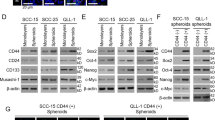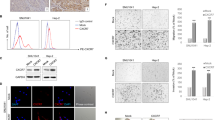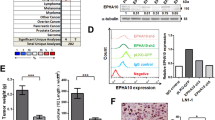Abstract
Head and neck squamous carcinomas (HNSCC) present as dense epithelioid three-dimensional (3D) tumor nests that can mediate signals via the human epidermal growth factor receptor (ErbB) tyrosine kinase family to promote intratumoral survival and growth. We examined the role of the tumor microenvironment on ErbB receptor family expression and found that the status of intercellular organization altered the receptor profile. We showed that HNSCC cells forced into tumor island-like 3D aggregates strongly upregulated ErbB3 at the level of transcription. Not only was the elevated ErbB3 responsive to HRG-β1-induced enhanced signaling mechanism, but also analysis by siRNA-knockdown and kinase inhibitor strategies revealed that the ErbB3/AKT signaling pathway was sufficient to enhance tumor cell survival and growth potential. Elevated ErbB3 expression in the high-density 3D culture system was strongly associated with hypoxia-induced HIF-1α. Hypoxia-regulated ErbB3 expression was mediated by the HIF-1α-binding consensus sequence in the ErbB3 proximal promoter. The findings show that the local 3D tumor microenvironment can trigger reprograming and switching of ErbB family members and thereby influence ErbB3-driven tumor growth.
This is a preview of subscription content, access via your institution
Access options
Subscribe to this journal
Receive 50 print issues and online access
$259.00 per year
only $5.18 per issue
Buy this article
- Purchase on Springer Link
- Instant access to full article PDF
Prices may be subject to local taxes which are calculated during checkout







Similar content being viewed by others
References
Rogers SJ, Harrington KJ, Rhys-Evans P, OC P, Eccles SA . Biological significance of c-erbB family oncogenes in head and neck cancer. Cancer Metastasis Rev 2005; 24: 47–69.
Leemans CR, Braakhuis BJ, Brakenhoff RH . The molecular biology of head and neck cancer. Nature Rev Cancer 2011; 11: 9–22.
Roskoski R Jr . The ErbB/HER family of protein-tyrosine kinases and cancer. Pharmacol Res 2014; 79: 34–74.
Ciardiello F, Tortora G . Epidermal growth factor receptor (EGFR) as a target in cancer therapy: understanding the role of receptor expression and other molecular determinants that could influence the response to anti-EGFR drugs. Eur J Cancer 2003; 39: 1348–1354.
Cavalot A, Martone T, Roggero N, Brondino G, Pagano M, Cortesina G . Prognostic impact of HER-2/neu expression on squamous head and neck carcinomas. Head Neck 2007; 29: 655–664.
Xia W, Lau YK, Zhang HZ, Liu AR, Li L, Kiyokawa N et al. Strong correlation between c-erbB-2 overexpression and overall survival of patients with oral squamous cell carcinoma. Clin Cancer Res 1997; 3: 3–9.
Rabinowits G, Haddad RI . Overcoming resistance to EGFR inhibitor in head and neck cancer: a review of the literature. Oral Oncol 2012; 48: 1085–1089.
Cohen RB . Current challenges and clinical investigations of epidermal growth factor receptor (EGFR)- and ErbB family-targeted agents in the treatment of head and neck squamous cell carcinoma (HNSCC). Cancer Treat Rev 2014; 40: 567–577.
Funayama T, Nakanishi T, Takahashi K, Taniguchi S, Takigawa M, Matsumura T . Overexpression of c-erbB-3 in various stages of human squamous cell carcinomas. Oncology 1998; 55: 161–167.
Sithanandam G, Anderson LM . The ERBB3 receptor in cancer and cancer gene therapy. Cancer Gene Ther 2008; 15: 413–448.
Del Sordo R, Angiero F, Bellezza G, Cavaliere A, Mameli MG, Stefani M et al. HER family receptors expression in squamous cell carcinoma of the tongue: study of the possible prognostic and biological significance. J Oral Pathol Med 39: 79–86.
Shintani S, Funayama T, Yoshihama Y, Alcalde RE, Matsumura T . Prognostic significance of ERBB3 overexpression in oral squamous cell carcinoma. Cancer Lett 1995; 95: 79–83.
Xia W, Lau YK, Zhang HZ, Xiao FY, Johnston DA, Liu AR et al. Combination of EGFR, HER-2/neu, and HER-3 is a stronger predictor for the outcome of oral squamous cell carcinoma than any individual family members. Clin Cancer Res 1999; 5: 4164–4174.
Jathal MK, Chen L, Mudryj M, Ghosh PM . Targeting ErbB3: the new RTK(id) on the prostate cancer block. Immunol Endocr Metab Agents Med Chem 2011; 11: 131–149.
Amin DN, Campbell MR, Moasser MM . The role of HER3, the unpretentious member of the HER family, in cancer biology and cancer therapeutics. Semin Cell Dev Biol 2010; 21: 944–950.
Wilson TR, Lee DY, Berry L, Shames DS, Settleman J . Neuregulin-1-mediated autocrine signaling underlies sensitivity to HER2 kinase inhibitors in a subset of human cancers. Cancer Cell 2011; 20: 158–172.
Shames DS, Carbon J, Walter K, Jubb AM, Kozlowski C, Januario T et al. High heregulin expression is associated with activated HER3 and may define an actionable biomarker in patients with squamous cell carcinomas of the head and neck. PLoS One 2013; 8: e56765.
Abbott A . Cell culture: biology's new dimension. Nature 2003; 424: 870–872.
Page H, Flood P, Reynaud EG . Three-dimensional tissue cultures: current trends and beyond. Cell Tissue Res 2013; 352: 123–131.
Hirschhaeuser F, Menne H, Dittfeld C, West J, Mueller-Klieser W, Kunz-Schughart LA . Multicellular tumor spheroids: an underestimated tool is catching up again. J Biotechnol 2010; 148: 3–15.
Bates RC, Edwards NS, Yates JD . Spheroids and cell survival. Crit Rev Oncol Hematol 2000; 36: 61–74.
Santini MT, Rainaldi G, Indovina PL . Apoptosis, cell adhesion and the extracellular matrix in the three-dimensional growth of multicellular tumor spheroids. Crit Rev Oncol Hematol 2000; 36: 75–87.
Friedrich J, Ebner R, Kunz-Schughart LA . Experimental anti-tumor therapy in 3-D: spheroids–old hat or new challenge? Int J Radiat Biol 2007; 83: 849–871.
Breslin S, O'Driscoll L . Three-dimensional cell culture: the missing link in drug discovery. Drug Discov Today 2013; 18: 240–249.
Humtsoe JO, Koya E, Pham E, Aramoto T, Zuo J, Ishikawa T et al. Transcriptional profiling identifies upregulated genes following induction of epithelial-mesenchymal transition in squamous carcinoma cells. Exp Cell Res 2012; 318: 379–390.
Ziober BL, Silverman SS Jr., Kramer RH . Adhesive mechanisms regulating invasion and metastasis in oral cancer. Crit Rev Oral Biol Med 2001; 12: 499–510.
Krig SR, Miller JK, Frietze S, Beckett LA, Neve RM, Farnham PJ et al. ZNF217, a candidate breast cancer oncogene amplified at 20q13, regulates expression of the ErbB3 receptor tyrosine kinase in breast cancer cells. Oncogene 29: 5500–5510.
Shweiki D, Neeman M, Itin A, Keshet E . Induction of vascular endothelial growth factor expression by hypoxia and by glucose deficiency in multicell spheroids: implications for tumor angiogenesis. Proc Natl Acad Sci USA 1995; 92: 768–772.
Chan DA, Kawahara TL, Sutphin PD, Chang HY, Chi JT, Giaccia AJ . Tumor vasculature is regulated by PHD2-mediated angiogenesis and bone marrow-derived cell recruitment. Cancer Cell 2009; 15: 527–538.
Zou Y, Cheng C, Omura-Minamisawa M, Kang Y, Hara T, Guan X et al. The suppression of hypoxia-inducible factor and vascular endothelial growth factor by siRNA does not affect the radiation sensitivity of multicellular tumor spheroids. J Radiat Res 2010; 51: 47–55.
Semenza GL . Defining the role of hypoxia-inducible factor 1 in cancer biology and therapeutics. Oncogene 29: 625–634.
Semenza GL, Wang GL . A nuclear factor induced by hypoxia via de novo protein synthesis binds to the human erythropoietin gene enhancer at a site required for transcriptional activation. Mol Cell Biol 1992; 12: 5447–5454.
Pickl M, Ries CH . Comparison of 3D and 2D tumor models reveals enhanced HER2 activation in 3D associated with an increased response to trastuzumab. Oncogene 2009; 28: 461–468.
Luca AC, Mersch S, Deenen R, Schmidt S, Messner I, Schafer KL et al. Impact of the 3D microenvironment on phenotype, gene expression, and EGFR inhibition of colorectal cancer cell lines. PLoS One 2013; 8: e59689.
Narayan M, Wilken JA, Harris LN, Baron AT, Kimbler KD, Maihle NJ et al. Trastuzumab-induced HER reprogramming in "resistant" breast carcinoma cells. Cancer Res 2009; 69: 2191–2194.
Sergina NV, Rausch M, Wang D, Blair J, Hann B, Shokat KM et al. Escape from HER-family tyrosine kinase inhibitor therapy by the kinase-inactive HER3. Nature 2007; 445: 437–441.
Jain A, Penuel E, Mink S, Schmidt J, Hodge A, Favero K et al. HER kinase axis receptor dimer partner switching occurs in response to EGFR tyrosine kinase inhibition despite failure to block cellular proliferation. Cancer Res 2010; 70: 1989–1999.
Garrett JT, Olivares MG, Rinehart C, Granja-Ingram ND, Sanchez V, Chakrabarty A et al. Transcriptional and posttranslational up-regulation of HER3 (ErbB3) compensates for inhibition of the HER2 tyrosine kinase. Proc Natl Acad Sci USA 2011; 108: 5021–5026.
Shi F, Telesco SE, Liu Y, Radhakrishnan R, Lemmon MA . ErbB3/HER3 intracellular domain is competent to bind ATP and catalyze autophosphorylation. Proc Natl Acad Sci USA 2010; 107: 7692–7697.
Dubessy C, Merlin JM, Marchal C, Guillemin F . Spheroids in radiobiology and photodynamic therapy. Crit Rev Oncol Hematol 2000; 36: 179–192.
Semenza GL . Hypoxia-inducible factors: mediators of cancer progression and targets for cancer therapy. Trends Pharmacol Sci 2012; 33: 207–214.
Perez-Sayans M, Suarez-Penaranda JM, Pilar GD, Barros-Angueira F, Gandara-Rey JM, Garcia-Garcia A . Hypoxia-inducible factors in OSCC. Cancer Lett 2011; 313: 1–8.
Paatero I, Seagroves TN, Vaparanta K, Han W, Jones FE, Johnson RS et al. Hypoxia-inducible factor-1alpha induces ErbB4 signaling in the differentiating mammary gland. J Biol Chem 2014; 289: 22459–22469.
Zhu CH, Huang Y, Oberley LW, Domann FE . A family of AP-2 proteins down-regulate manganese superoxide dismutase expression. J Biol Chem 2001; 276: 14407–14413.
Krig SR, Miller JK, Frietze S, Beckett LA, Neve RM, Farnham PJ et al. ZNF217, a candidate breast cancer oncogene amplified at 20q13, regulates expression of the ErbB3 receptor tyrosine kinase in breast cancer cells. Oncogene 2010; 29: 5500–5510.
Scott GK, Goga A, Bhaumik D, Berger CE, Sullivan CS, Benz CC . Coordinate suppression of ERBB2 and ERBB3 by enforced expression of micro-RNA miR-125a or miR-125b. J Biol Chem 2007; 282: 1479–1486.
Iorio MV, Casalini P, Piovan C, Di Leva G, Merlo A, Triulzi T et al. microRNA-205 regulates HER3 in human breast cancer. Cancer Res 2009; 69: 2195–2200.
He J, Xu Q, Jing Y, Agani F, Qian X, Carpenter R et al. Reactive oxygen species regulate ERBB2 and ERBB3 expression via miR-199a/125b and DNA methylation. EMBO Rep 2012; 13: 1116–1122.
Amin DN, Sergina N, Lim L, Goga A, Moasser MM . HER3 signalling is regulated through a multitude of redundant mechanisms in HER2-driven tumour cells. Biochem J 2012; 447: 417–425.
Abel EV, Basile KJ, Kugel CH 3rd, Witkiewicz AK, Le K, Amaravadi RK et al. Melanoma adapts to RAF/MEK inhibitors through FOXD3-mediated upregulation of ERBB3. J Clin Invest 2013; 123: 2155–2168.
Dery MA, Michaud MD, Richard DE . Hypoxia-inducible factor 1: regulation by hypoxic and non-hypoxic activators. Int J Biochem Cell Biol 2005; 37: 535–540.
Agani F, Jiang BH . Oxygen-independent regulation of HIF-1: novel involvement of PI3K/AKT/mTOR pathway in cancer. Curr Cancer Drug Targets 2013; 13: 245–251.
Xia C, Meng Q, Liu LZ, Rojanasakul Y, Wang XR, Jiang BH . Reactive oxygen species regulate angiogenesis and tumor growth through vascular endothelial growth factor. Cancer Res 2007; 67: 10823–10830.
Sasabe E, Yang Z, Ohno S, Yamamoto T . Reactive oxygen species produced by the knockdown of manganese-superoxide dismutase up-regulate hypoxia-inducible factor-1alpha expression in oral squamous cell carcinoma cells. Free Radic Biol Med 2010; 48: 1321–1329.
Takikita M, Xie R, Chung JY, Cho H, Ylaya K, Hong SM et al. Membranous expression of Her3 is associated with a decreased survival in head and neck squamous cell carcinoma. J Transl Med 2011; 9: 126.
Matsumoto K, Horikoshi M, Rikimaru K, Enomoto S . A study of an in vitro model for invasion of oral squamous cell carcinoma. J Oral Pathol Med 1989; 18: 498–501.
Chen Q, Lipkina G, Song Q, Kramer RH . Promoter methylation regulates cadherin switching in squamous cell carcinoma. Biochem Biophys Res Commun 2004; 315: 850–856.
Zuo J, Ishikawa T, Boutros S, Xiao Z, Humtsoe JO, Kramer RH . Bcl-2 overexpression induces a partial epithelial to mesenchymal transition and promotes squamous carcinoma cell invasion and metastasis. Mol Cancer Res 2010; 8: 170–182.
Humtsoe JO, Kramer RH . Differential epidermal growth factor receptor signaling regulates anchorage-independent growth by modulation of the PI3K/AKT pathway. Oncogene 2010; 29: 1214–1226.
Acknowledgements
We thank Dr Colleen Sweeney (University of California at Davis) for the kind gift of the ErbB3-promoter constructs and Dr Fan Yang (University of California San Francisco) for providing samples of xenograft specimens. This research was supported by grants from UCSF REAC Award (to RHK), Cancer Research Coordinating Committee (to RHK), and National Institutes of Health, R01 DE022565 (to RHK).
Author information
Authors and Affiliations
Corresponding author
Ethics declarations
Competing interests
The authors declare no conflict of interest.
Additional information
Supplementary Information accompanies this paper on the Oncogene website
Supplementary information
Rights and permissions
About this article
Cite this article
Humtsoe, J., Pham, E., Louie, R. et al. ErbB3 upregulation by the HNSCC 3D microenvironment modulates cell survival and growth. Oncogene 35, 1554–1564 (2016). https://doi.org/10.1038/onc.2015.220
Received:
Revised:
Accepted:
Published:
Issue Date:
DOI: https://doi.org/10.1038/onc.2015.220
This article is cited by
-
Biallelic ERBB3 loss-of-function variants are associated with a novel multisystem syndrome without congenital contracture
Orphanet Journal of Rare Diseases (2019)
-
Anti-Trop2 blockade enhances the therapeutic efficacy of ErbB3 inhibition in head and neck squamous cell carcinoma
Cell Death & Disease (2018)
-
Amplified centrosomes and mitotic index display poor concordance between patient tumors and cultured cancer cells
Scientific Reports (2017)



